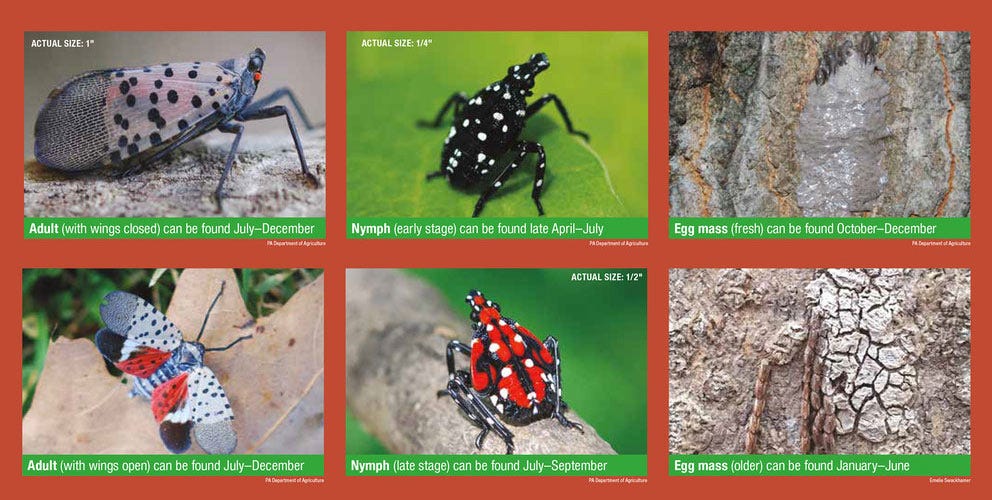Beware the Spotted Lanternfly
go.ncsu.edu/readext?835274
en Español / em Português
El inglés es el idioma de control de esta página. En la medida en que haya algún conflicto entre la traducción al inglés y la traducción, el inglés prevalece.
Al hacer clic en el enlace de traducción se activa un servicio de traducción gratuito para convertir la página al español. Al igual que con cualquier traducción por Internet, la conversión no es sensible al contexto y puede que no traduzca el texto en su significado original. NC State Extension no garantiza la exactitud del texto traducido. Por favor, tenga en cuenta que algunas aplicaciones y/o servicios pueden no funcionar como se espera cuando se traducen.
Português
Inglês é o idioma de controle desta página. Na medida que haja algum conflito entre o texto original em Inglês e a tradução, o Inglês prevalece.
Ao clicar no link de tradução, um serviço gratuito de tradução será ativado para converter a página para o Português. Como em qualquer tradução pela internet, a conversão não é sensivel ao contexto e pode não ocorrer a tradução para o significado orginal. O serviço de Extensão da Carolina do Norte (NC State Extension) não garante a exatidão do texto traduzido. Por favor, observe que algumas funções ou serviços podem não funcionar como esperado após a tradução.
English
English is the controlling language of this page. To the extent there is any conflict between the English text and the translation, English controls.
Clicking on the translation link activates a free translation service to convert the page to Spanish. As with any Internet translation, the conversion is not context-sensitive and may not translate the text to its original meaning. NC State Extension does not guarantee the accuracy of the translated text. Please note that some applications and/or services may not function as expected when translated.
Collapse ▲The spotted lanternfly is an invasive planthopper that was first discovered in the United States in Pennsylvania in 2014. Since that time, this pest has spread to most of the New England States including Massachusetts, Connecticut, Delaware, Maryland, New Jersey, and New York. In addition to these New England States, it has also spread to Ohio, West Virginia, and Indiana. Unfortunately, this pest was discovered in Hillside, Virginia in October of 2021, just 30 miles north of Mt. Airy NC.
This pest feeds on over 170 species of plants including grapes, fruit trees, pine trees, oaks, maples, sycamore, birch, tulip poplar, willow, and dogwood. They feed by sucking on sap from the stems, leaves, and trunks of the trees causing them to develop weeping wounds that leave a gray or black trail of sap down the trunk. This sap attracts other insects, and the wounds can lead to future disease issues. This could be detrimental for our local vineyards as this pest can reduce grape yields by 90%.
According to research, most of these new infestations are caused by moving egg masses from one location to another during the fall of the year. The spotted lanternfly will lay their eggs on most anything including plants, machinery, boats, trailers, campers, firewood, stone, or on the underside of cars. They will overwinter and hatch in the spring to form a new infestation.
One area of major concern is egg masses being laid on Christmas Trees coming out of Virginia. Officials with the NC Forest Service are urging Christmas tree producers to inspect their trees for the pest this holiday season and are encouraging buyers to keep an eye out for the spotted lanternfly or their egg masses on their live cut Christmas trees this year.
If you spot, or think you find a spotted lanternfly or its egg mass you should take a picture, collect the specimen, and report it to the N.C. Department of Agriculture and Consumer Services. You can email badbug@ncagr.gov and use the subject line “Suspected spotted lanternfly.” For more information, you can visit The N.C. Department of Agriculture and Consumer Services’ spotted lanternfly website.




